Disability: Support Models, Abuse Indicators, and Tech Impact
VerifiedAdded on 2023/06/10
|5
|990
|105
Homework Assignment
AI Summary
This assignment provides a comprehensive overview of disability, examining different models of support such as the medical and social models, and contrasting institutional and person-centered approaches. It addresses seeking support in team settings, support practices for individuals with genetic factors, and the importance of clear work role principles. The impact of technology on promoting independence for people with disabilities is highlighted, along with methods for lodging complaints and recognizing signs of abuse, including physical, behavioral, and sexual indicators. The assignment references various sources to support its analysis of disability-related issues. Desklib offers further study materials including past papers and solved assignments.
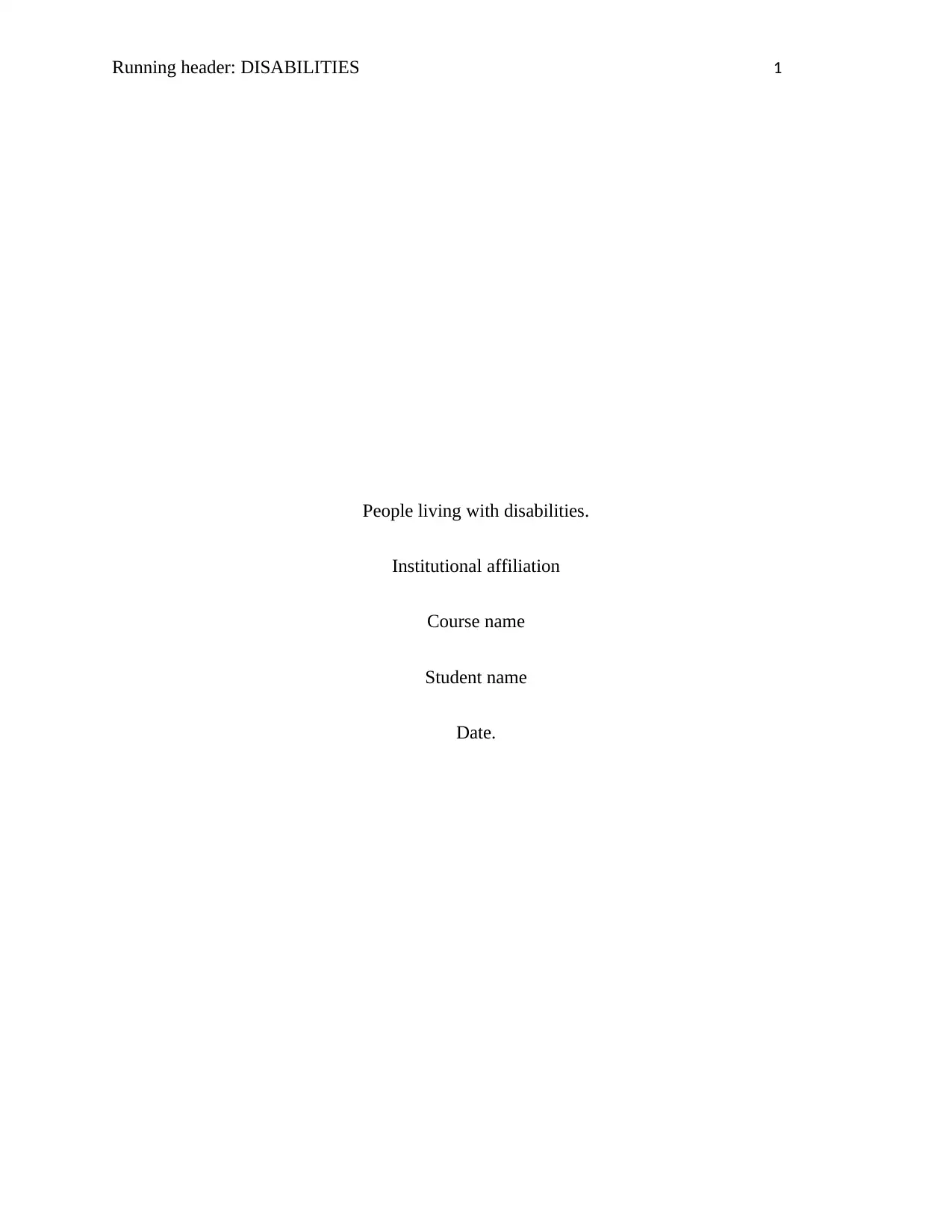
Running header: DISABILITIES 1
People living with disabilities.
Institutional affiliation
Course name
Student name
Date.
People living with disabilities.
Institutional affiliation
Course name
Student name
Date.
Paraphrase This Document
Need a fresh take? Get an instant paraphrase of this document with our AI Paraphraser
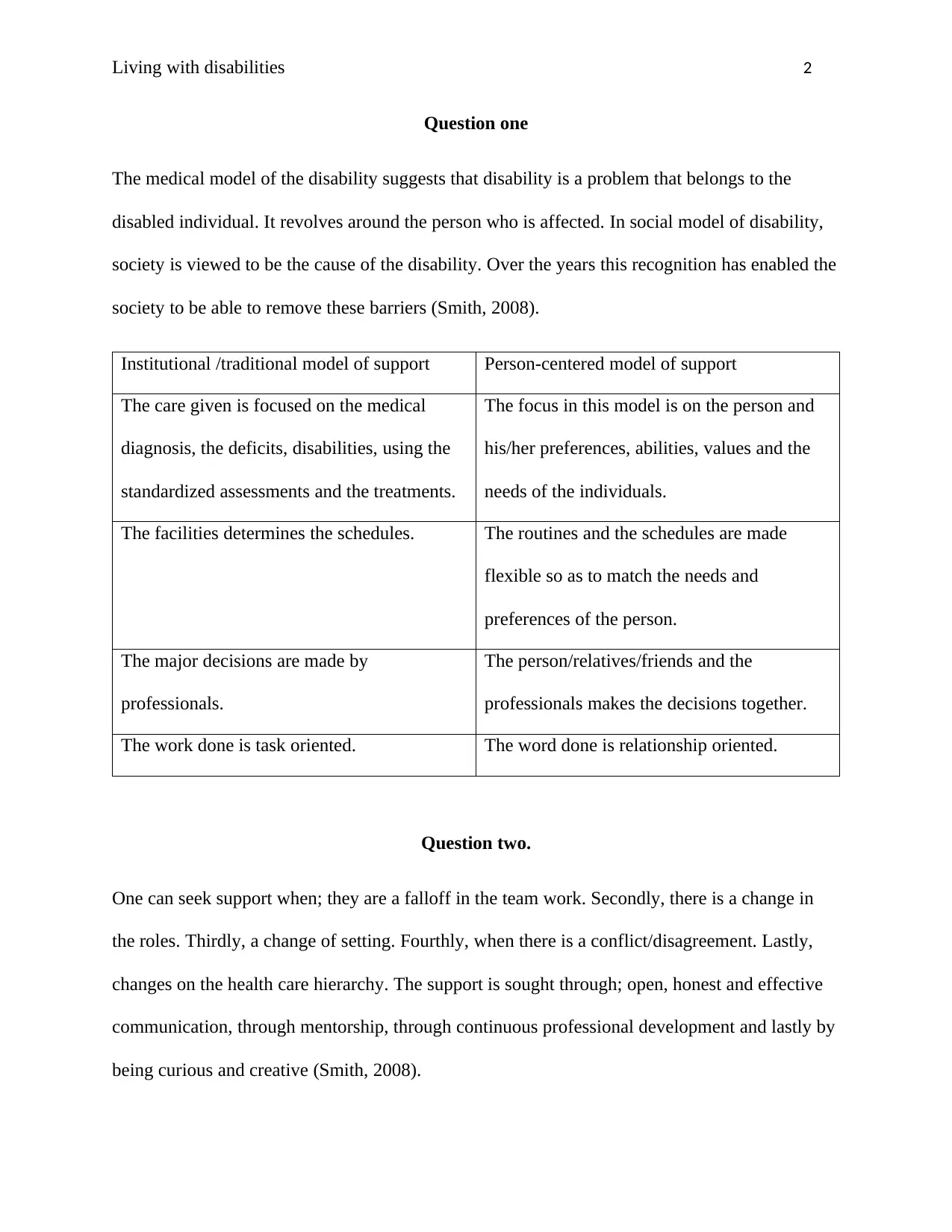
Living with disabilities 2
Question one
The medical model of the disability suggests that disability is a problem that belongs to the
disabled individual. It revolves around the person who is affected. In social model of disability,
society is viewed to be the cause of the disability. Over the years this recognition has enabled the
society to be able to remove these barriers (Smith, 2008).
Institutional /traditional model of support Person-centered model of support
The care given is focused on the medical
diagnosis, the deficits, disabilities, using the
standardized assessments and the treatments.
The focus in this model is on the person and
his/her preferences, abilities, values and the
needs of the individuals.
The facilities determines the schedules. The routines and the schedules are made
flexible so as to match the needs and
preferences of the person.
The major decisions are made by
professionals.
The person/relatives/friends and the
professionals makes the decisions together.
The work done is task oriented. The word done is relationship oriented.
Question two.
One can seek support when; they are a falloff in the team work. Secondly, there is a change in
the roles. Thirdly, a change of setting. Fourthly, when there is a conflict/disagreement. Lastly,
changes on the health care hierarchy. The support is sought through; open, honest and effective
communication, through mentorship, through continuous professional development and lastly by
being curious and creative (Smith, 2008).
Question one
The medical model of the disability suggests that disability is a problem that belongs to the
disabled individual. It revolves around the person who is affected. In social model of disability,
society is viewed to be the cause of the disability. Over the years this recognition has enabled the
society to be able to remove these barriers (Smith, 2008).
Institutional /traditional model of support Person-centered model of support
The care given is focused on the medical
diagnosis, the deficits, disabilities, using the
standardized assessments and the treatments.
The focus in this model is on the person and
his/her preferences, abilities, values and the
needs of the individuals.
The facilities determines the schedules. The routines and the schedules are made
flexible so as to match the needs and
preferences of the person.
The major decisions are made by
professionals.
The person/relatives/friends and the
professionals makes the decisions together.
The work done is task oriented. The word done is relationship oriented.
Question two.
One can seek support when; they are a falloff in the team work. Secondly, there is a change in
the roles. Thirdly, a change of setting. Fourthly, when there is a conflict/disagreement. Lastly,
changes on the health care hierarchy. The support is sought through; open, honest and effective
communication, through mentorship, through continuous professional development and lastly by
being curious and creative (Smith, 2008).
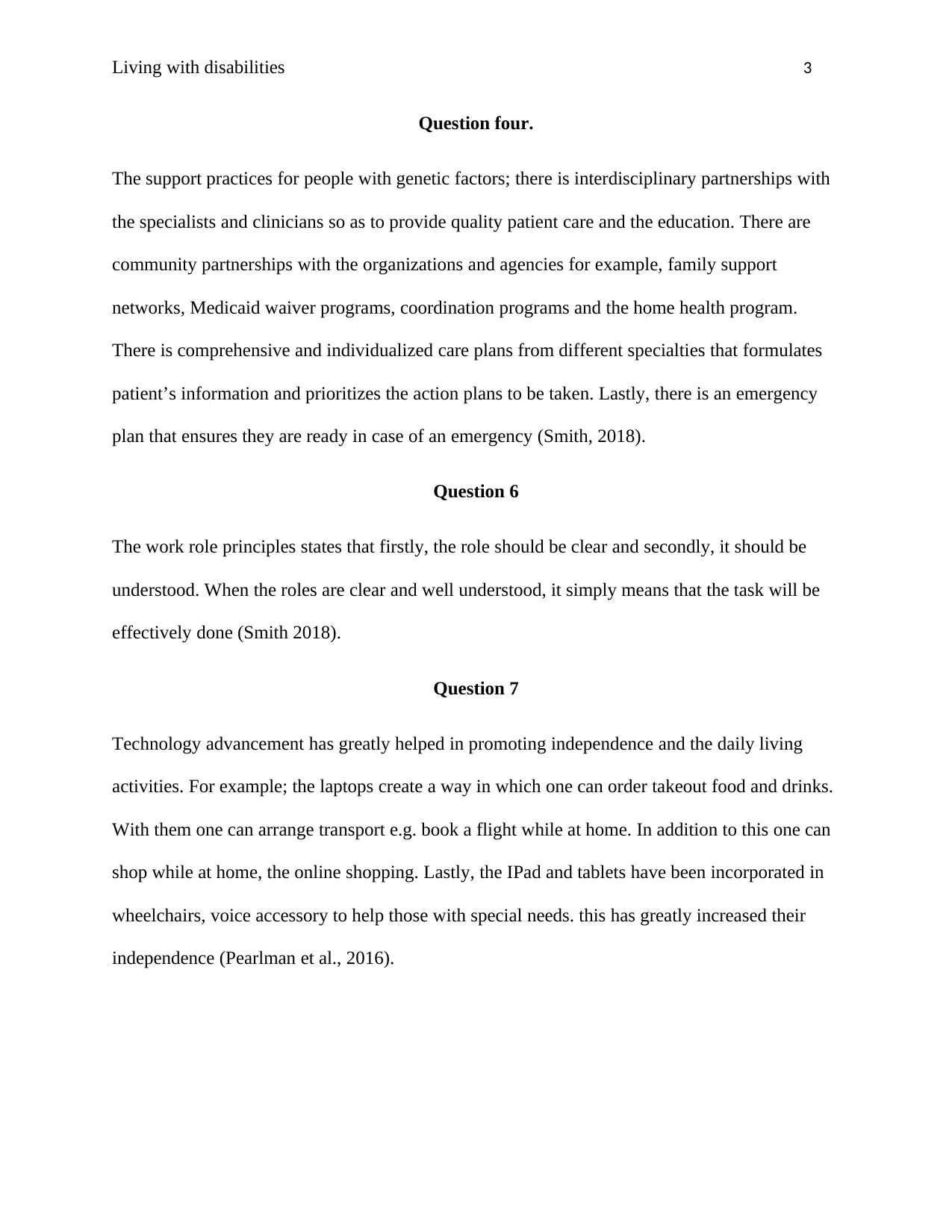
Living with disabilities 3
Question four.
The support practices for people with genetic factors; there is interdisciplinary partnerships with
the specialists and clinicians so as to provide quality patient care and the education. There are
community partnerships with the organizations and agencies for example, family support
networks, Medicaid waiver programs, coordination programs and the home health program.
There is comprehensive and individualized care plans from different specialties that formulates
patient’s information and prioritizes the action plans to be taken. Lastly, there is an emergency
plan that ensures they are ready in case of an emergency (Smith, 2018).
Question 6
The work role principles states that firstly, the role should be clear and secondly, it should be
understood. When the roles are clear and well understood, it simply means that the task will be
effectively done (Smith 2018).
Question 7
Technology advancement has greatly helped in promoting independence and the daily living
activities. For example; the laptops create a way in which one can order takeout food and drinks.
With them one can arrange transport e.g. book a flight while at home. In addition to this one can
shop while at home, the online shopping. Lastly, the IPad and tablets have been incorporated in
wheelchairs, voice accessory to help those with special needs. this has greatly increased their
independence (Pearlman et al., 2016).
Question four.
The support practices for people with genetic factors; there is interdisciplinary partnerships with
the specialists and clinicians so as to provide quality patient care and the education. There are
community partnerships with the organizations and agencies for example, family support
networks, Medicaid waiver programs, coordination programs and the home health program.
There is comprehensive and individualized care plans from different specialties that formulates
patient’s information and prioritizes the action plans to be taken. Lastly, there is an emergency
plan that ensures they are ready in case of an emergency (Smith, 2018).
Question 6
The work role principles states that firstly, the role should be clear and secondly, it should be
understood. When the roles are clear and well understood, it simply means that the task will be
effectively done (Smith 2018).
Question 7
Technology advancement has greatly helped in promoting independence and the daily living
activities. For example; the laptops create a way in which one can order takeout food and drinks.
With them one can arrange transport e.g. book a flight while at home. In addition to this one can
shop while at home, the online shopping. Lastly, the IPad and tablets have been incorporated in
wheelchairs, voice accessory to help those with special needs. this has greatly increased their
independence (Pearlman et al., 2016).
⊘ This is a preview!⊘
Do you want full access?
Subscribe today to unlock all pages.

Trusted by 1+ million students worldwide
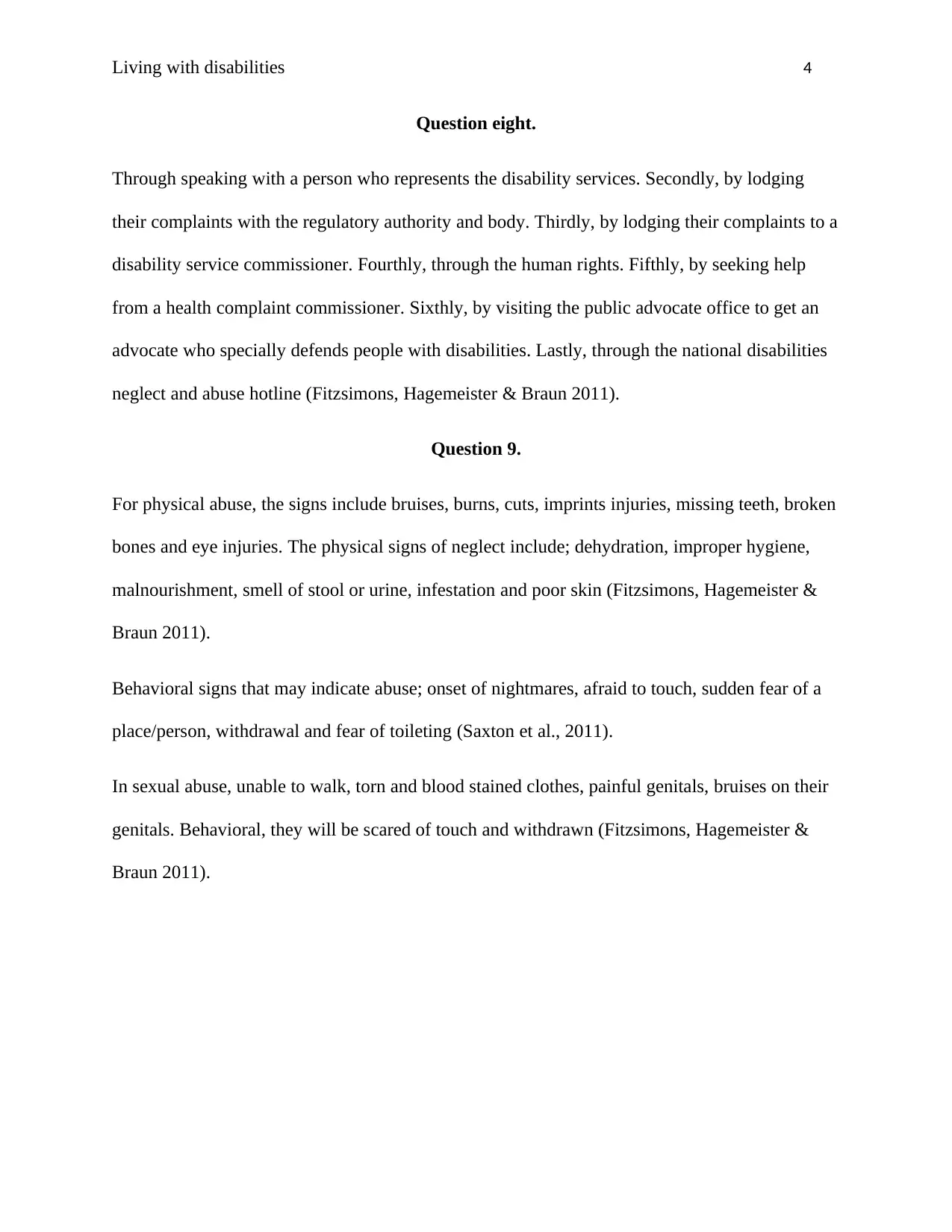
Living with disabilities 4
Question eight.
Through speaking with a person who represents the disability services. Secondly, by lodging
their complaints with the regulatory authority and body. Thirdly, by lodging their complaints to a
disability service commissioner. Fourthly, through the human rights. Fifthly, by seeking help
from a health complaint commissioner. Sixthly, by visiting the public advocate office to get an
advocate who specially defends people with disabilities. Lastly, through the national disabilities
neglect and abuse hotline (Fitzsimons, Hagemeister & Braun 2011).
Question 9.
For physical abuse, the signs include bruises, burns, cuts, imprints injuries, missing teeth, broken
bones and eye injuries. The physical signs of neglect include; dehydration, improper hygiene,
malnourishment, smell of stool or urine, infestation and poor skin (Fitzsimons, Hagemeister &
Braun 2011).
Behavioral signs that may indicate abuse; onset of nightmares, afraid to touch, sudden fear of a
place/person, withdrawal and fear of toileting (Saxton et al., 2011).
In sexual abuse, unable to walk, torn and blood stained clothes, painful genitals, bruises on their
genitals. Behavioral, they will be scared of touch and withdrawn (Fitzsimons, Hagemeister &
Braun 2011).
Question eight.
Through speaking with a person who represents the disability services. Secondly, by lodging
their complaints with the regulatory authority and body. Thirdly, by lodging their complaints to a
disability service commissioner. Fourthly, through the human rights. Fifthly, by seeking help
from a health complaint commissioner. Sixthly, by visiting the public advocate office to get an
advocate who specially defends people with disabilities. Lastly, through the national disabilities
neglect and abuse hotline (Fitzsimons, Hagemeister & Braun 2011).
Question 9.
For physical abuse, the signs include bruises, burns, cuts, imprints injuries, missing teeth, broken
bones and eye injuries. The physical signs of neglect include; dehydration, improper hygiene,
malnourishment, smell of stool or urine, infestation and poor skin (Fitzsimons, Hagemeister &
Braun 2011).
Behavioral signs that may indicate abuse; onset of nightmares, afraid to touch, sudden fear of a
place/person, withdrawal and fear of toileting (Saxton et al., 2011).
In sexual abuse, unable to walk, torn and blood stained clothes, painful genitals, bruises on their
genitals. Behavioral, they will be scared of touch and withdrawn (Fitzsimons, Hagemeister &
Braun 2011).
Paraphrase This Document
Need a fresh take? Get an instant paraphrase of this document with our AI Paraphraser
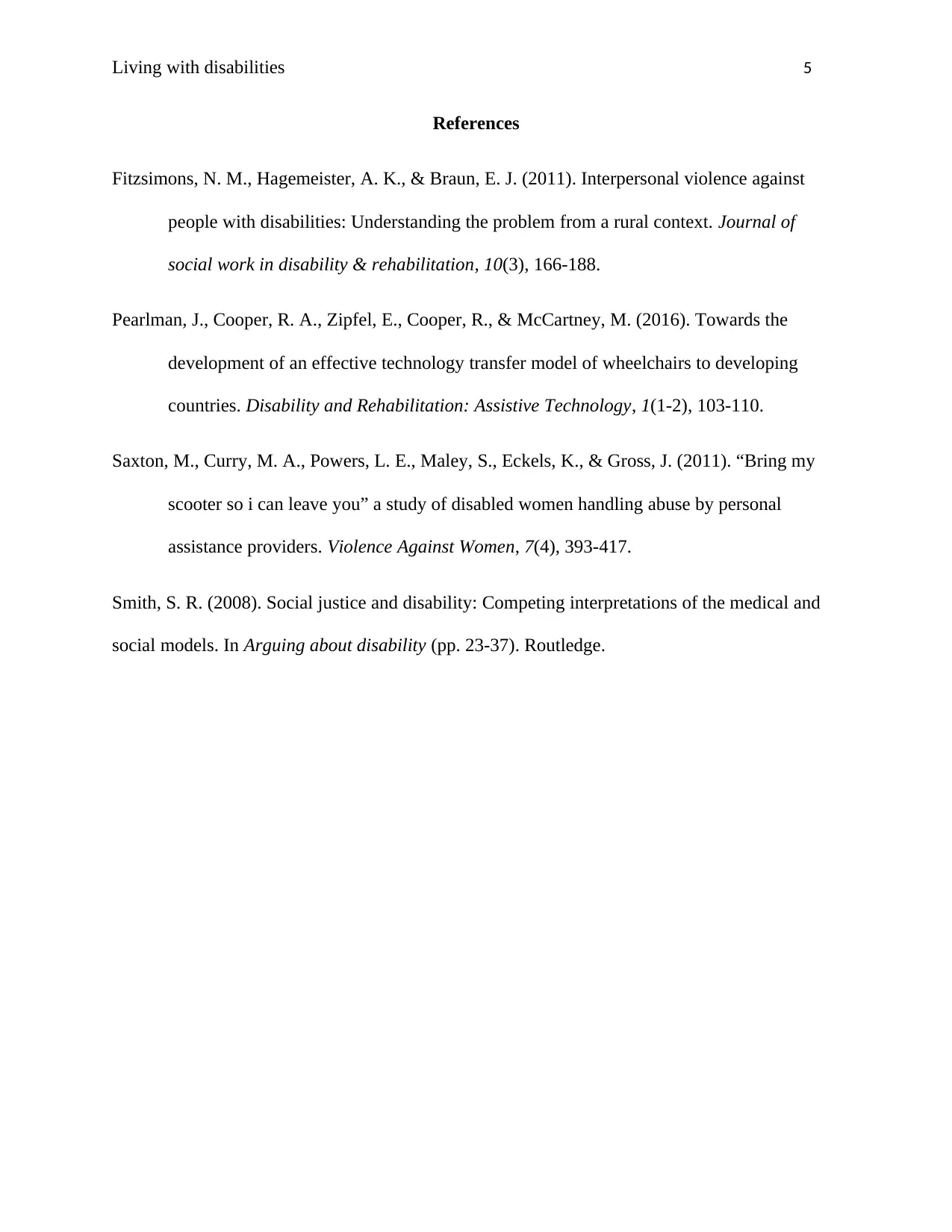
Living with disabilities 5
References
Fitzsimons, N. M., Hagemeister, A. K., & Braun, E. J. (2011). Interpersonal violence against
people with disabilities: Understanding the problem from a rural context. Journal of
social work in disability & rehabilitation, 10(3), 166-188.
Pearlman, J., Cooper, R. A., Zipfel, E., Cooper, R., & McCartney, M. (2016). Towards the
development of an effective technology transfer model of wheelchairs to developing
countries. Disability and Rehabilitation: Assistive Technology, 1(1-2), 103-110.
Saxton, M., Curry, M. A., Powers, L. E., Maley, S., Eckels, K., & Gross, J. (2011). “Bring my
scooter so i can leave you” a study of disabled women handling abuse by personal
assistance providers. Violence Against Women, 7(4), 393-417.
Smith, S. R. (2008). Social justice and disability: Competing interpretations of the medical and
social models. In Arguing about disability (pp. 23-37). Routledge.
References
Fitzsimons, N. M., Hagemeister, A. K., & Braun, E. J. (2011). Interpersonal violence against
people with disabilities: Understanding the problem from a rural context. Journal of
social work in disability & rehabilitation, 10(3), 166-188.
Pearlman, J., Cooper, R. A., Zipfel, E., Cooper, R., & McCartney, M. (2016). Towards the
development of an effective technology transfer model of wheelchairs to developing
countries. Disability and Rehabilitation: Assistive Technology, 1(1-2), 103-110.
Saxton, M., Curry, M. A., Powers, L. E., Maley, S., Eckels, K., & Gross, J. (2011). “Bring my
scooter so i can leave you” a study of disabled women handling abuse by personal
assistance providers. Violence Against Women, 7(4), 393-417.
Smith, S. R. (2008). Social justice and disability: Competing interpretations of the medical and
social models. In Arguing about disability (pp. 23-37). Routledge.
1 out of 5
Your All-in-One AI-Powered Toolkit for Academic Success.
+13062052269
info@desklib.com
Available 24*7 on WhatsApp / Email
![[object Object]](/_next/static/media/star-bottom.7253800d.svg)
Unlock your academic potential
Copyright © 2020–2025 A2Z Services. All Rights Reserved. Developed and managed by ZUCOL.

